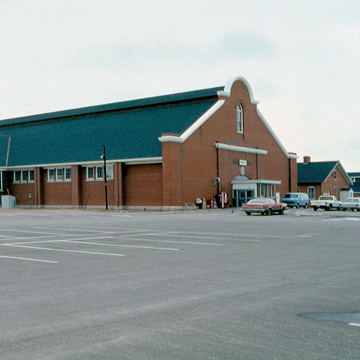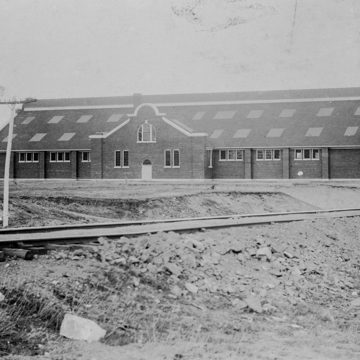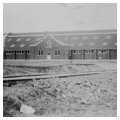You are here
Freedom Hall
Horses were critical to Army operations in the nineteenth and early twentieth centuries. All soldiers and officers posted to Fort D. A. Russell would have ridden horses, putting the count at several thousand. The last horse did not leave the post until 1943. Taking proper care of military horses was a prime concern for the Army. The Drill Hall on F.E. Warren Air Force Base was built as an indoor exercise arena to keep horses fit and capable for duty even during the harsh winter months. This facility was also used to host horse shows and polo matches.
The 30,000-square-foot brick arena has a rectangular main block with a front gable and monitor roof. There are projecting center pavilions on the east and west elevations. The gable ends have molded metal cornices and shouldered parapets culminating in Flemish-inspired round arches at the peaks. Large front and rear gable end windows are 15-over-15 sash topped by 10-light, round-arched fanlights. Side-elevation windows are 9-over-9-light single sash, grouped in threes beneath the eaves. The wide, segmentally arched central entry is set in a tall, slightly projecting pavilion.
In the 1960s, once horses had been removed from the base, the original interior was completely renovated: the dirt riding arena was paved with concrete and the Drill Hall converted to the Military Commissary. In the 1980s it was converted to a gymnasium with an indoor track, shower facilities, and weight room.
References
Installation Planning and Design Guide. F E Warren Air Force Base. April 1984.
Hoagland, Alison K. Army Architecture in the West: Forts Laramie, Bridger and D. A. Russell, 1849–1912. Norman: University of Oklahoma Press, 2014.
Writing Credits
If SAH Archipedia has been useful to you, please consider supporting it.
SAH Archipedia tells the story of the United States through its buildings, landscapes, and cities. This freely available resource empowers the public with authoritative knowledge that deepens their understanding and appreciation of the built environment. But the Society of Architectural Historians, which created SAH Archipedia with University of Virginia Press, needs your support to maintain the high-caliber research, writing, photography, cartography, editing, design, and programming that make SAH Archipedia a trusted online resource available to all who value the history of place, heritage tourism, and learning.




